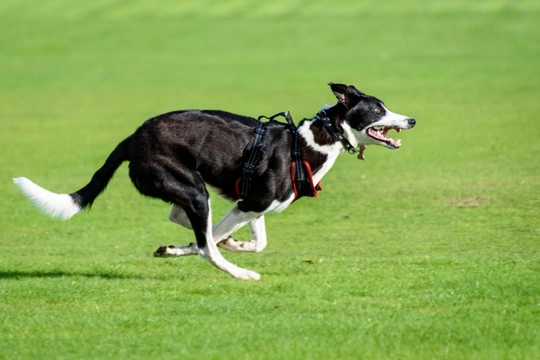
Ten things you need to know about the lurcher before you buy one
The lurcher is a type of sighthound that consists of the crossing of a greyhound with a dog of any other breed, most commonly working and pastoral dog breeds like terriers or collies. Originally associated with hunting hares (sometimes referred to as “lamping,”) lurchers were historically generally thought of as poacher’s dogs, but today are hugely popular as pets.
Lurchers have a lot of very positive traits that ensure that they’re reliably popular in the UK – the 35th most popular dog type of all, in fact. They’re very middle of the road in most ways which ensures that they’re a good fit for lots of different types of owners, but lurchers aren’t suitable pets for everyone, and anyone considering buying one needs to do plenty of research first.
With this in mind, this article will tell you ten things you need to know about the lurcher dog type, before you buy one. Read on to learn more.
Lurchers aren’t pedigree dogs
First of all, the lurcher is a cross breed, which means that they’re not pedigree dogs and as such, aren’t recognised by the Kennel Club. There’s no breed standard in place for the lurcher dog type, and they can’t be entered into Kennel Club breed shows.
None of these points are a huge problem for the majority of lurcher owners, but pedigree status is important to some dog owners, and so this is worth mentioning!
…So they can be quite variable in appearance and temperament
Whilst one of the breeds used to produce a lurcher is by definition a greyhound, the other breed can be a dog of any type, which ultimately means that any two lurchers might be quite different in terms of their appearances, temperaments, and core traits.
Generally they are around medium sized although again with reasonable scope for variance, and may have short, close-cropped coats or rather shaggier coats in more or less any shade.
Lurchers do tend to have a typical sighthound build, with long legs, a narrow body yet deep chest, and a long, pointed nose.
They’re very economical to buy and keep
Lurchers are perhaps the least costly dog type to buy; in fact, based on the average asking prices listed by advertisers on Pets4Homes over the last year, the average asking price per dog was just £265.
They also tend to be fairly economical to keep too, although larger lurchers will cost more to feed and provide with accessories than smaller ones.
They are really fast
Thanks to their greyhound ancestry and sighthound traits, a lurcher in full gallop is a very fast dog, and they can easily outrun people and the vast majority of other dogs, other than some other sighthounds.
This means that training your lurcher not to run off, providing an enclosed safe space for off the lead exercise, and keeping them in sight at all times is vitally important.
But also often really lazy!
One trait that most sighthounds have in common is that they expend their energy in short bursts of high-energy running or sprinting, but are generally very sedentary the rest of the time.
Lurchers, like greyhounds, spend a lot of time sleeping and lazing around, and whilst they do require sufficient exercise, they’re not the most onerous of dog breeds to provide for in this respect.
They have an incredibly high prey drive
Lurchers were originally prized for their skills as hunting dogs that could sight, outrun and promptly catch small prey like hares and rabbits. This means that dogs of this type have an incredibly high prey drive, and it is virtually impossible to train them out of this.
They can and will chase and catch wildlife and even domestic cats if not properly controlled and managed, and this means that lurchers need to be kept on the lead when out in public, muzzled when running off the lead in spaces where smaller animals might be present, and only permitted to run freely in enclosed areas.
They tend to be healthy and long lived
Lurchers have the benefit of hybrid vigour, and they tend to be fairly healthy dogs that usually live for around 12-15 years, although this can of course vary considerably from dog to dog.
However, their fine limbs are potentially more susceptible to damage than most stockier dog breeds, and they are so one track minded about pursuing prey that they are at risk of becoming injured in pursuit, which is another reason why it is important to properly supervise off the lead exercise.
Their coats are low maintenance
Lurcher coats can vary from short and close cropped to shaggy and coarse, but they all tend to be fairly low maintenance and not much hassle to take care of. Like all dogs, they need the occasional bath and can benefit from regular brushing and grooming, but taking care of the lurcher coat won’t generally cause you too many problems.
They’re personable, sensitive and affectionate
Lurchers tend to be friendly if a little quiet, and they are very personable and affectionate dogs that are gentle and loving, and very nice to have around. They are quite sensitive dogs and don’t like a huge amount of noise and rowdiness, and they will soon become distressed if spoken to harshly or ignored.
They’re a great fit for many different types of owners
Lurchers have a great many good points to recommend them as suitable pets for a wide variety of different types of dog owners, and they are one of the dog types that is widely considered to be suitable for even a first-time dog owner.
However, the importance of managing the dog’s prey drive and the challenges that this can bring should not be overlooked, which is something any prospective lurcher owner needs to consider carefully before going ahead with a purchase.



